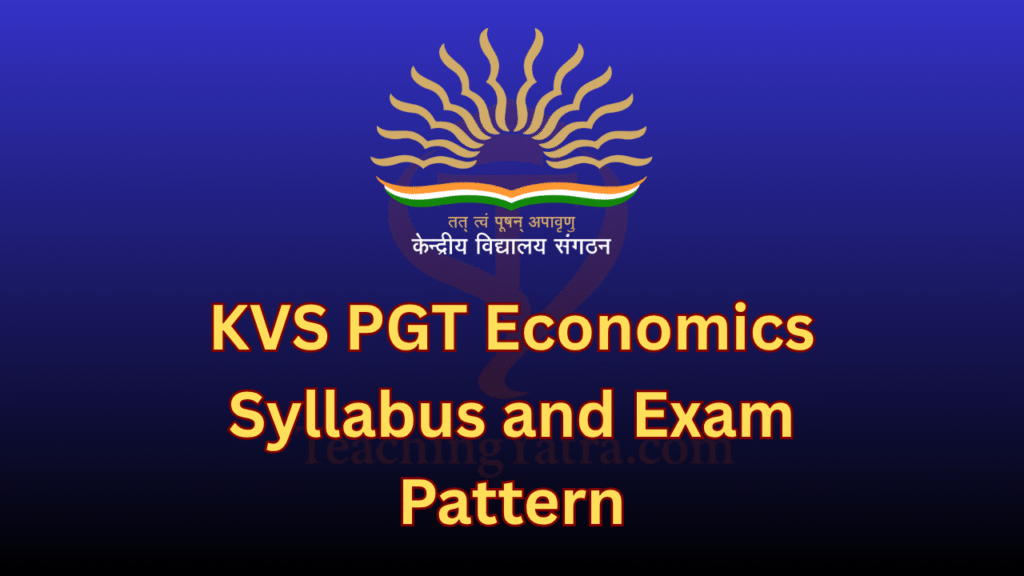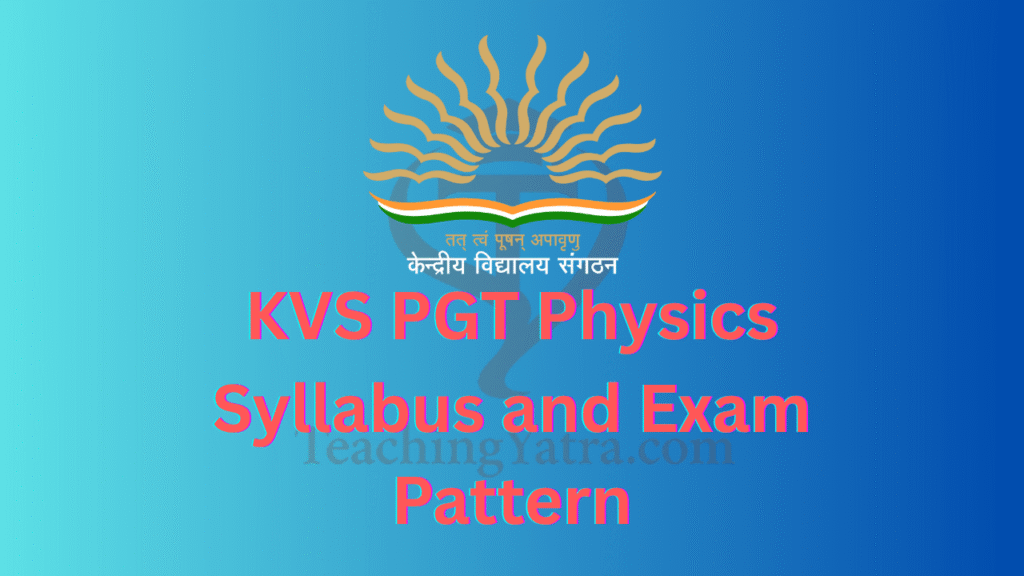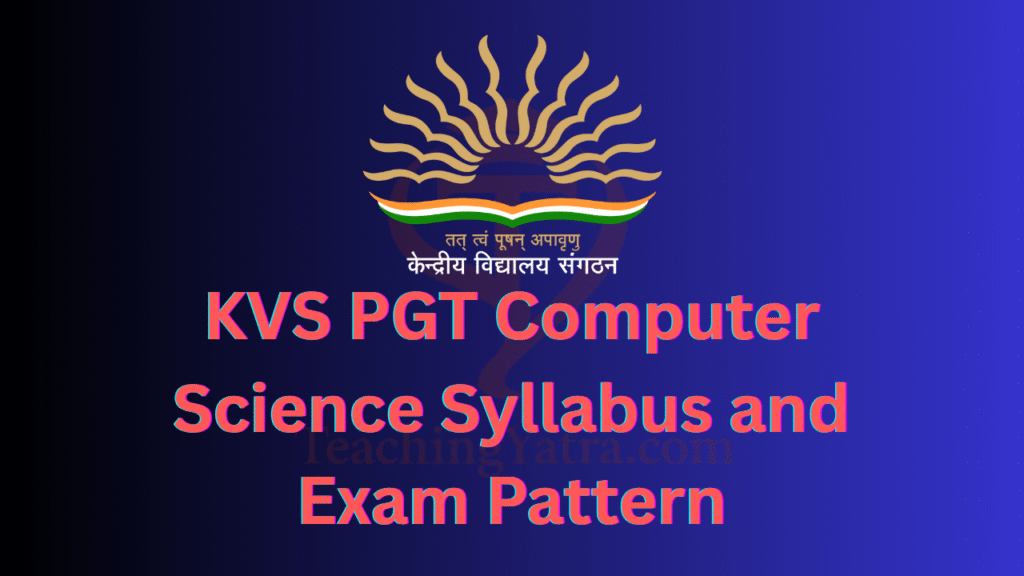
Download the KVS PGT Economics Syllabus 2025 PDF and prepare better with a detailed topic-wise guide. Know the exam pattern, marking scheme, and important subjects based on NCERT. Start your preparation with confidence to crack the KVS Economics exam.
If you are preparing for the KVS PGT Economics Exam 2025, first go through the official syllabus carefully. You can find the KVS PGT Economics Syllabus 2025 on the official Kendriya Vidyalaya Sangathan (KVS) website. To improve your chances of success, download the complete syllabus PDF from the link below and follow a proper topic-wise study plan. Understanding the syllabus will help you focus on important topics, manage your time well, and confidently aim for the Post Graduate Teacher (Economics) post.
Table of Contents
KVS PGT Economics Syllabus: Overview
The KVS PGT Economics Syllabus 2025 lists all the important subjects and topics that candidates must study to do well in the exam conducted by Kendriya Vidyalaya Sangathan (KVS). To prepare effectively, it’s important to stay updated with official notifications and go through the latest syllabus carefully. A smart and focused study plan based on the syllabus will help boost your preparation and improve your chances of getting selected as a Post Graduate Teacher (Economics).
KVS PGT Economics Exam Pattern 2025
Knowing the exam pattern is very important for better preparation. It tells you how many questions will be asked, total marks, marking scheme, time duration, and language of the exam. Understanding this helps you plan your study time smartly and attempt the paper with confidence.
Exam Pattern Highlights
- Total Questions: 180
- Total Marks: 180
- Time Duration: 3 Hours (180 minutes)
- Medium of Exam: English and Hindi (Bilingual)
- Question Type: Objective Type (Multiple Choice Questions)
- Subject: Economics (PGT level)
KVS PGT Economics Marks Distribution 2025
The exam is divided into 4 main parts with 7 sub-sections:
| Part | Subjects | No. of Questions | Marks |
|---|---|---|---|
| Part I | General English | 10 | 10 |
| General Hindi | 10 | 10 | |
| Part II | General Awareness & Current Affairs | 10 | 10 |
| Reasoning Ability | 5 | 5 | |
| Computer Literacy | 5 | 5 | |
| Part III | Perspectives on Education & Leadership | 40 | 40 |
| Part IV | Economics (Subject-specific) | 100 | 100 |
| Total | 180 | 180 |
This structure gives a complete overview of the exam and helps candidates prepare in a planned and confident way.
Detailed KVS PGT Economics Syllabus 2025
Subject specific syllabus includes the concepts of NCERT/CBSE syllabus and Text Books (Classes XI & XII), however, the questions will be testing the depth of understanding and application of these concepts at the level of Post- Graduation.
Introduction
Meaning, scope, functions and importance of statistics in Economics
Collection, Organisation and Presentation of data
• Collection of data – sources of data – primary and secondary; how basic data is collected with concepts of Sampling; methods of collecting data; some important sources of secondary data: Census of India and National Sample Survey Organisation.
• Organisation of Data: Meaning and types of variables; Frequency Distribution.
• Presentation of Data: Tabular Presentation and Diagrammatic Presentation of Data: (i) Geometric forms (bar diagrams and pie diagrams), (ii) Frequency diagrams (histogram, polygon and Ogive) and (iii) Arithmetic line graphs (time series graph).
Statistical Tools and Interpretation
• Measures of Central Tendency- Arithmetic mean, median and mode
• Correlation – meaning and properties, scatter diagram; Measures of correlation – Karl Pearson’s method (two variables ungrouped data) Spearman’s rank correlation.
• Introduction to Index Numbers – meaning, types – wholesale price index, consumer price index and index of industrial production, uses of index numbers; Inflation and index numbers.
Introduction to Microeconomics
• Meaning of microeconomics and macroeconomics; positive and normative economics
• What is an economy? Central problems of an economy: what, how and for whom to produce; concepts of production possibility frontier and opportunity cost.
Consumer’s Equilibrium and Demand
• Consumer’s equilibrium – meaning of utility, marginal utility, law of diminishing marginal utility, conditions of consumer’s equilibrium using marginal utility analysis.
• Indifference curve analysis of consumer’s equilibrium-the consumer’s budget (budget set and budget line), preferences of the consumer (indifference curve, indifference map) and conditions of consumer’s equilibrium.
• Demand, market demand, determinants of demand, demand schedule, demand curve and its slope, movement along and shifts in the demand curve; price elasticity of demand – factors affecting price elasticity of demand; measurement of price elasticity of demand – percentage-change method and total expenditure method.
Producer Behaviour and Supply
• Meaning of Production Function – Short-Run and Long-Run
• Total Product, Average Product and Marginal Product.
• Returns to a Factor
• Cost: Short run costs – total cost, total fixed cost, total variable cost; Average cost; Average fixed cost, average variable cost and marginal cost-meaning and their relationships.
• Revenue – total, average and marginal revenue – meaning and their relationship.
• Producer’s equilibrium-meaning and its conditions in terms of marginal revenue marginal cost. Supply, market supply, determinants of supply, supply schedule, supply curve and its slope, movements along and shifts in supply curve, price elasticity of supply; measurement of price elasticity of supply – percentage-change method.
Forms of Market and Price Determination under Perfect Competition with simple applications
• Perfect competition – Features; Determination of market equilibrium and effects of shifts in demand and supply.
• Simple Applications of Demand and Supply: Price ceiling, price floor.
National Income and Related Aggregates
• Basic concepts in macroeconomics: consumption goods, capital goods, final goods, intermediate goods; stocks and flows; gross investment and depreciation.
• Circular flow of income (two sector model); Methods of calculating National Income – Value Added or Product method, Expenditure method, Income method.
• Aggregates related to National Income: Gross National Product (GNP), Net National Product (NNP), Gross Domestic Product (GDP) and Net Domestic Product (NDP) – at market price, at factor cost; Real and Nominal GDP.
• GDP and Welfare
Money and Banking
• Money – meaning and functions, supply of money – Currency held by the public and net demand deposits held by commercial banks.
• Money creation by the commercial banking system.
• Central bank and its functions (example of the Reserve Bank of India): Bank of issue, Govt. Bank, Banker’s Bank, Control of Credit through Bank Rate, CRR, SLR, Repo Rate and Reverse Repo Rate, Open Market Operations, Margin requirement.
Determination of Income and Employment
• Aggregate demand and its components.
• Propensity to consume and propensity to save (average and marginal).
• Short-run equilibrium output; investment multiplier and its mechanism.
• Meaning of full employment and involuntary unemployment.
• Problems of excess demand and deficient demand; measures to correct them – changes in government spending, taxes and money supply.
Government Budget and the Economy
• Government budget – meaning, objectives and components.
• Classification of receipts – revenue receipts and capital receipts;
• Classification of expenditure – revenue expenditure and capital expenditure.
• Balanced, Surplus and Deficit Budget – measures of government deficit.
Balance of Payments
• Balance of payments account – meaning and components;
• Balance of payments – Surplus and Deficit
• Foreign exchange rate – meaning of fixed and flexible rates and managed floating.
• Determination of exchange rate in a free market, Merits and demerits of flexible and fixed exchange rate. Managed Floating exchange rate system
Development Experience (1947-90) and Economic Reforms since 1991
• A brief introduction of the state of Indian economy on the eve of independence. Indian economic system and common goals of Five Year Plans.
• Main features, problems and policies of agriculture (institutional aspects and new agricultural strategy), industry (IPR 1956; SSI – role & importance) and foreign trade.
• Economic Reforms since 1991:
Features and appraisals of liberalisation, globalisation and privatisation (LPG policy); Concepts of demonetization and GST
Current challenges facing Indian Economy
• Human Capital Formation: How people become resource; Role of human capital in economic development; Growth of Education Sector in India
• Rural development: Key issues – credit and marketing – role of cooperatives; agricultural diversification; alternative farming – organic farming
• Employment: Growth and changes in work force participation rate in formal and informal sectors; problems and policies
• Sustainable Economic Development: Meaning, Effects of Economic Development on Resources and Environment, including global warming
Development Experience of India
• A comparison with neighbours
• India and Pakistan
• India and China
• Issues: economic growth, population, sectoral development and other Human Development Indicators
Detailed KVS PGT Economics Syllabus 2025 in Hindi
विषय-विशेष पाठ्यक्रम में कक्षा 11वीं और 12वीं की NCERT/CBSE की पाठ्यपुस्तकों की अवधारणाएँ सम्मिलित हैं, लेकिन प्रश्नों में इन अवधारणाओं की पोस्ट-ग्रेजुएट स्तर पर समझ और अनुप्रयोग की गहराई को परखा जाएगा।
परिचय
आर्थिक सांख्यिकी का अर्थ, क्षेत्र, कार्य और महत्त्व
आंकड़ों का संग्रहण, संगठन और प्रस्तुति
• आंकड़ों का संग्रहण – आंकड़ों के स्रोत – प्राथमिक और द्वितीयक; प्राथमिक आंकड़े एकत्र करने के तरीके; सैम्पलिंग की अवधारणा; आंकड़े एकत्र करने की विधियाँ; द्वितीयक आंकड़ों के प्रमुख स्रोत: भारत की जनगणना और राष्ट्रीय सैम्पल सर्वेक्षण संगठन।
• आंकड़ों का संगठन: चर का अर्थ और प्रकार; आवृत्ति वितरण।
• आंकड़ों की प्रस्तुति: सारणीबद्ध प्रस्तुति और रेखाचित्रात्मक प्रस्तुति: (i) ज्यामितीय रूप (बार डायग्राम और पाई चार्ट), (ii) आवृत्ति चित्र (हिस्टोग्राम, पॉलीगॉन और ओगिव) और (iii) अंक रेखा चित्र (समय श्रंखला ग्राफ)।
सांख्यिकीय उपकरण और व्याख्या
• केंद्री प्रवृत्ति के माप – अंकगणितीय औसत, माध्यिका और बहुलक
• सहसंबंध – अर्थ और गुण, स्कैटर डायग्राम; सहसंबंध के माप – कार्ल पियर्सन विधि (दो चर, असमूहित आंकड़े) और स्पीयरमैन रैंक सहसंबंध
• सूचकांक संख्याओं का परिचय – अर्थ, प्रकार – थोक मूल्य सूचकांक, उपभोक्ता मूल्य सूचकांक और औद्योगिक उत्पादन सूचकांक, सूचकांक संख्याओं का उपयोग; मुद्रास्फीति और सूचकांक संख्याएँ
सूक्ष्म अर्थशास्त्र का परिचय
• सूक्ष्म और समष्टि अर्थशास्त्र का अर्थ; सकारात्मक और मानक अर्थशास्त्र
• अर्थव्यवस्था क्या है? अर्थव्यवस्था की केंद्रीय समस्याएं: क्या, कैसे और किसके लिए उत्पादन करें; उत्पादन संभावना वक्र और अवसर लागत की अवधारणा
उपभोक्ता संतुलन और मांग
• उपभोक्ता संतुलन – उपयोगिता का अर्थ, सीमांत उपयोगिता, घटती सीमांत उपयोगिता का नियम, सीमांत उपयोगिता विश्लेषण द्वारा उपभोक्ता संतुलन की शर्तें
• उदासीनता वक्र विश्लेषण द्वारा उपभोक्ता संतुलन – उपभोक्ता का बजट (बजट सेट और बजट रेखा), उपभोक्ता की प्राथमिकताएँ (उदासीनता वक्र, उदासीनता मानचित्र) और उपभोक्ता संतुलन की शर्तें
• मांग, बाजार मांग, मांग के निर्धारक, मांग अनुसूची, मांग वक्र और उसका ढाल, मांग वक्र में गति और बदलाव; मूल्य लोच – मूल्य लोच को प्रभावित करने वाले कारक; मूल्य लोच मापन – प्रतिशत परिवर्तन विधि और कुल व्यय विधि
उत्पादक व्यवहार और आपूर्ति
• उत्पादन फलन का अर्थ – अल्पकाल और दीर्घकाल
• कुल उत्पाद, औसत उत्पाद और सीमांत उत्पाद
• घटते प्रतिफल का नियम
• लागत: अल्पकालिक लागतें – कुल लागत, कुल स्थिर लागत, कुल परिवर्तनीय लागत; औसत लागत; औसत स्थिर लागत, औसत परिवर्तनीय लागत और सीमांत लागत – अर्थ और उनके आपसी संबंध
• आय – कुल, औसत और सीमांत आय – अर्थ और उनके आपसी संबंध
• उत्पादक संतुलन – अर्थ और सीमांत आय व सीमांत लागत के संदर्भ में उसकी शर्तें। आपूर्ति, बाजार आपूर्ति, आपूर्ति के निर्धारक, आपूर्ति अनुसूची, आपूर्ति वक्र और उसका ढाल, आपूर्ति वक्र में गति और बदलाव; मूल्य लोच – मूल्य लोच का मापन – प्रतिशत परिवर्तन विधि
बाज़ार के रूप और पूर्ण प्रतियोगिता के अंतर्गत मूल्य निर्धारण
• पूर्ण प्रतियोगिता – विशेषताएँ; बाज़ार संतुलन का निर्धारण और मांग एवं आपूर्ति में बदलाव के प्रभाव
• मांग और आपूर्ति के सरल अनुप्रयोग: मूल्य सीमा, मूल्य तल
राष्ट्रीय आय और संबंधित समष्टियाँ
• समष्टि अर्थशास्त्र की मूल अवधारणाएँ: उपभोग वस्तुएं, पूंजी वस्तुएं, अंतिम वस्तुएं, मध्यवर्ती वस्तुएं; स्टॉक्स और फ्लो; सकल निवेश और मूल्यह्रास
• आय का परिसंचरण (दो क्षेत्रीय मॉडल); राष्ट्रीय आय की गणना की विधियाँ – उत्पाद विधि, व्यय विधि, आय विधि
• राष्ट्रीय आय से संबंधित समष्टियाँ: सकल राष्ट्रीय उत्पाद (GNP), शुद्ध राष्ट्रीय उत्पाद (NNP), सकल घरेलू उत्पाद (GDP), शुद्ध घरेलू उत्पाद (NDP) – बाज़ार मूल्य पर, कारक लागत पर; वास्तविक और नाममात्र GDP
• GDP और कल्याण
मुद्रा और बैंकिंग
• मुद्रा – अर्थ और कार्य, मुद्रा की आपूर्ति – जनता द्वारा रखी गई मुद्रा और वाणिज्यिक बैंकों में शुद्ध माँग जमा
• वाणिज्यिक बैंकिंग प्रणाली द्वारा मुद्रा निर्माण
• केंद्रीय बैंक और उसके कार्य (भारतीय रिज़र्व बैंक के उदाहरण से): मुद्रा निर्गमन, सरकार का बैंक, बैंकों का बैंक, बैंक दर, CRR, SLR, रेपो दर और रिवर्स रेपो दर, खुले बाज़ार का संचालन, मार्जिन आवश्यकता द्वारा ऋण नियंत्रण
आय और रोजगार का निर्धारण
• समग्र मांग और इसके घटक
• उपभोग प्रवृत्ति और बचत प्रवृत्ति (औसत और सीमांत)
• अल्पकालीन संतुलन उत्पादन; निवेश गुणक और उसका तंत्र
• पूर्ण रोजगार और अनैच्छिक बेरोजगारी का अर्थ
• अधिक मांग और अपर्याप्त मांग की समस्याएं; समाधान – सरकारी व्यय, करों और मुद्रा आपूर्ति में बदलाव
सरकारी बजट और अर्थव्यवस्था
• सरकारी बजट – अर्थ, उद्देश्य और घटक
• आय की श्रेणीकरण – राजस्व प्राप्तियाँ और पूंजीगत प्राप्तियाँ
• व्यय का श्रेणीकरण – राजस्व व्यय और पूंजीगत व्यय
• संतुलित, अधिशेष और घाटे का बजट – सरकार के घाटे के मापन
भुगतान संतुलन
• भुगतान संतुलन खाता – अर्थ और घटक
• भुगतान संतुलन – अधिशेष और घाटा
• विदेशी विनिमय दर – स्थिर, लचीली और प्रबंधित लचीलापन दर का अर्थ
• मुक्त बाजार में विनिमय दर का निर्धारण, स्थिर और लचीली विनिमय दर के लाभ और हानियाँ, प्रबंधित लचीलापन विनिमय दर प्रणाली
विकास अनुभव (1947-90) और 1991 के बाद आर्थिक सुधार
• स्वतंत्रता की पूर्व संध्या पर भारतीय अर्थव्यवस्था की स्थिति का संक्षिप्त परिचय। भारतीय आर्थिक प्रणाली और पंचवर्षीय योजनाओं के सामान्य लक्ष्य
• कृषि (संस्थागत पहलू और नई कृषि रणनीति), उद्योग (औद्योगिक नीति 1956, लघु उद्योग – भूमिका एवं महत्त्व) और विदेशी व्यापार की मुख्य विशेषताएँ, समस्याएं और नीतियाँ
• 1991 के बाद के आर्थिक सुधार:
उदारीकरण, वैश्वीकरण और निजीकरण (LPG नीति) की विशेषताएं और मूल्यांकन; विमुद्रीकरण और GST की अवधारणाएं
भारतीय अर्थव्यवस्था के समक्ष वर्तमान चुनौतियाँ
• मानव पूंजी निर्माण: लोग संसाधन कैसे बनते हैं; आर्थिक विकास में मानव पूंजी की भूमिका; भारत में शिक्षा क्षेत्र का विकास
• ग्रामीण विकास: मुख्य मुद्दे – ऋण और विपणन – सहकारी समितियों की भूमिका; कृषि विविधीकरण; वैकल्पिक खेती – जैविक खेती
• रोजगार: कार्यबल भागीदारी दर में वृद्धि और बदलाव (औपचारिक और अनौपचारिक क्षेत्रों में); समस्याएँ और नीतियाँ
• सतत आर्थिक विकास: अर्थ, संसाधनों और पर्यावरण पर आर्थिक विकास का प्रभाव, जिसमें वैश्विक तापवृद्धि शामिल है
भारत का विकास अनुभव
• पड़ोसी देशों से तुलना
• भारत और पाकिस्तान
• भारत और चीन
• मुद्दे: आर्थिक विकास, जनसंख्या, क्षेत्रीय विकास और अन्य मानव विकास संकेतक

